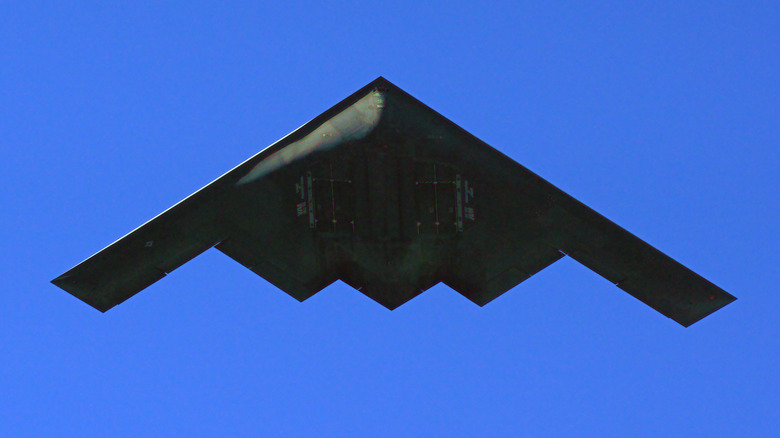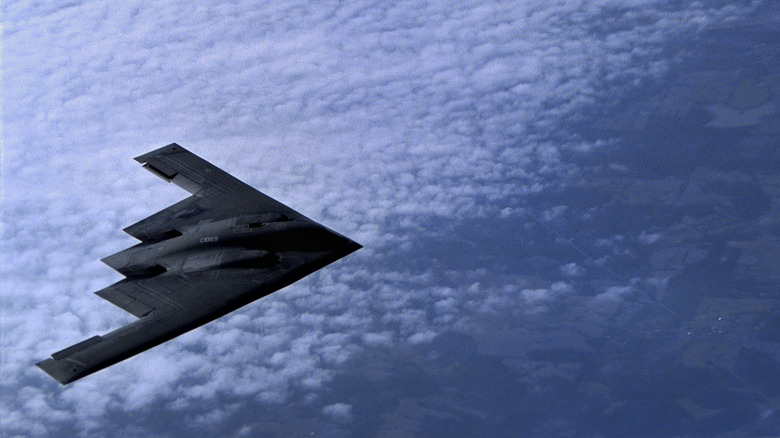Every B-2 Bomber Was Grounded For 6 Months This Year: Here's Why
Stealth aircraft are among the most extraordinary military vehicles to behold. Stealth bombers, in particular, were designed to boast a seemingly impossible mix of devastating payload firepower and almost imperceptible stealth. What deadlier weapon could there be?
The sleek and angular B-2 bomber from the U.S., needless to say, packs some remarkable technology under its triangular hood. Electromagnetic and infrared technology are just two of the secretive systems it uses both offensively and defensively to confound foes and remain undetected. The universal law of technology applies as ever, though: the more features something boasts, the more chances there are for something to go wrong.
Earlier in 2023, a potential issue was discovered with the aircraft — one potentially so severe that the whole fleet was grounded for a full six months. Here's what happened to the iconic B-2, and how the situation led to every single one of them being out of commission for so long. It may have been more of a precautionary measure, but it was a necessary one.
A fateful fire
In December of 2022, a B-2 performed an emergency landing at Whiteman Air Force Base in Missouri. Its personnel were able to safely maneuver to the ground unharmed, but a fire crew then had to intervene to douse the stricken aircraft. According to Air Force Times, an issue with the B-2's systems had set in while the aircraft was mid-flight — the details of the malfunction have not been disclosed.
It seemed that the incident was, thankfully, far less major than it could have been. However, the world of aviation is not a place to take risks. For the sake of crews and the aircraft (each of which is worth an astonishing $1 billion), it was vital to investigate the cause of the incident to determine if the rest of the B-2 fleet could be susceptible to the issue.
While this work was underway, the bombers remained grounded. Explaining the decision, Air Force Colonel Daniel Diehl stated to The Hill that "Our number one concern is the safety and security of our personnel and fleet."
With safety and security being paramount, the military also emphasized that it would continue to wield as much power as ever while the B-2 was out of action. According to The Hill, Pentagon press secretary, Brigadier General Pat Ryder, emphasized to reporters that there would continue to be "aircraft, ships, forces on the ground available to confront any threat that ... may pop up. So no vulnerabilities at this time."
The B-2's return to action
There were 20 B-2s in service when the incident occurred, and though they remained out of action for this long period, they didn't necessarily have to. On May 22, 2023, the Air Force Global Strike Command issued a post on X (formerly Twitter) confirming that the B-2s were cleared to fly again, and that they were maintained to the highest standards of readiness throughout the hiatus. Had they been needed, they could have taken off and joined the fray before this.
The military — understandably keen not to share any more information about their mighty B-2 than strictly necessary — opted not to disclose the exact cause of the mechanical issue. It seems clear from this, though, that it was not deemed an issue of great lingering concern, nor did it appear to be one that affected the fleet more broadly.
The Congressional Research Service notes that the intent is to slowly phase out the B-2, potentially in favor of the imposing B-21 Raider. The broad timeframe to complete this objective is "by 2040," and doing so would potentially result in a net increase in the number of such aircraft at the United States' disposal.
As the B-21 becomes more prominent (100 are slated to be purchased by the Department of Defense), military personnel and others are surely hoping that no such disruptive events occur again. That would potentially mean five times as many aircraft would need to be monitored and grounded if similar circumstances arose.


